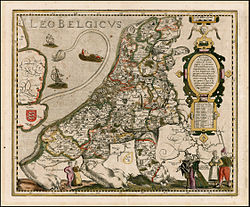Leo Belgicus
The Leo Belgicus ( Latin for Lion of Belgica ) has been a popular motif in Dutch cartography since the 16th century .
Basic idea
The Austrian chronicler Michael Aitzinger published the first Leo Belgicus , engraved by Frans Hogenberg , in his historical work De Leone Belgico in 1583 . The book deals with contemporary Dutch history from 1559 to 1583 from a Spanish perspective. As Aitzing explains in the preface, the representation of the seventeen provinces as a lion is intended to graphically illustrate the power and strength of the country struggling for independence. The adjective belgicus is derived from the Roman province of Gallia Belgica and describes the entire Benelux region in Neo Latin .
On Aitzing's map - as on most copies - the lion stands on its hind paws with its back to the sea, its head and right front paw facing northeast. The lion's open mouth shows a powerful tongue, and the long tail plays around the English coast. In later depictions the lion occasionally holds a sword in its paws.
With the Leo Belgicus, Aitzing took up a further backward heraldic tradition. The lion as heraldic animal can be found on the coats of arms of all seven provinces, which later formed the United Netherlands , on the coats of arms of some southern provinces ( Flanders , Brabant , Luxembourg , Hainaut) and on the coat of arms of the House of Nassau .
Survival
The basic idea of Aitzing's map was varied many times in the following centuries, but now in a Dutch-patriotic sense. Especially in the independent northern Netherlands, but also sometimes in the southern part of the country that remained with the Holy Roman Empire , the lion was a symbol of the former political unity of the region. Well-known Leones Belgici come from Claes Janszoon Visscher (1609) and Pieter van den Keere (1617). The former published a reduced version for the first time in 1648 under the title Leo Hollandicus , which only depicts Holland . Finally, Jodocus Hondius designed a vest-like Leo Belgicus that looks in the opposite direction to the southwest.
"Leo Belgicus" is also the title of a historical treatise by Philipp von Zesen (published 1660 (Latin); German version 1677 as Dutch people ).
Examples
Frans Hogenberg (1583)
Claes Janszoon Visscher (1609)
Jodocus Hondius (1611)
Related motifs
There are also representations of countries in the form of figures for other motifs, such as the Europa Regina in the early modern period .
literature
- Henk AM van der Heijden: Leo Belgicus. An illustrated and annotated carto-bibliography. 2nd revised edition. Canaletto, Alphen aan den Rijn 2006, ISBN 90-6469-644-6 .
- Henk AM van der Heijden: Keizer Karel en de leeuw. De oorsprong van de Nederlandse cartografie en de Leo Belgicus. Canaletto et al., Alphen aan den Rijn et al. 2000, ISBN 90-6469-761-2 .
- Gerald Sammet: The world of cards. Historical and modern cartography in dialogue. Wissen-Media-Verlag, Gütersloh et al. 2008, ISBN 978-3-577-07251-9 .




